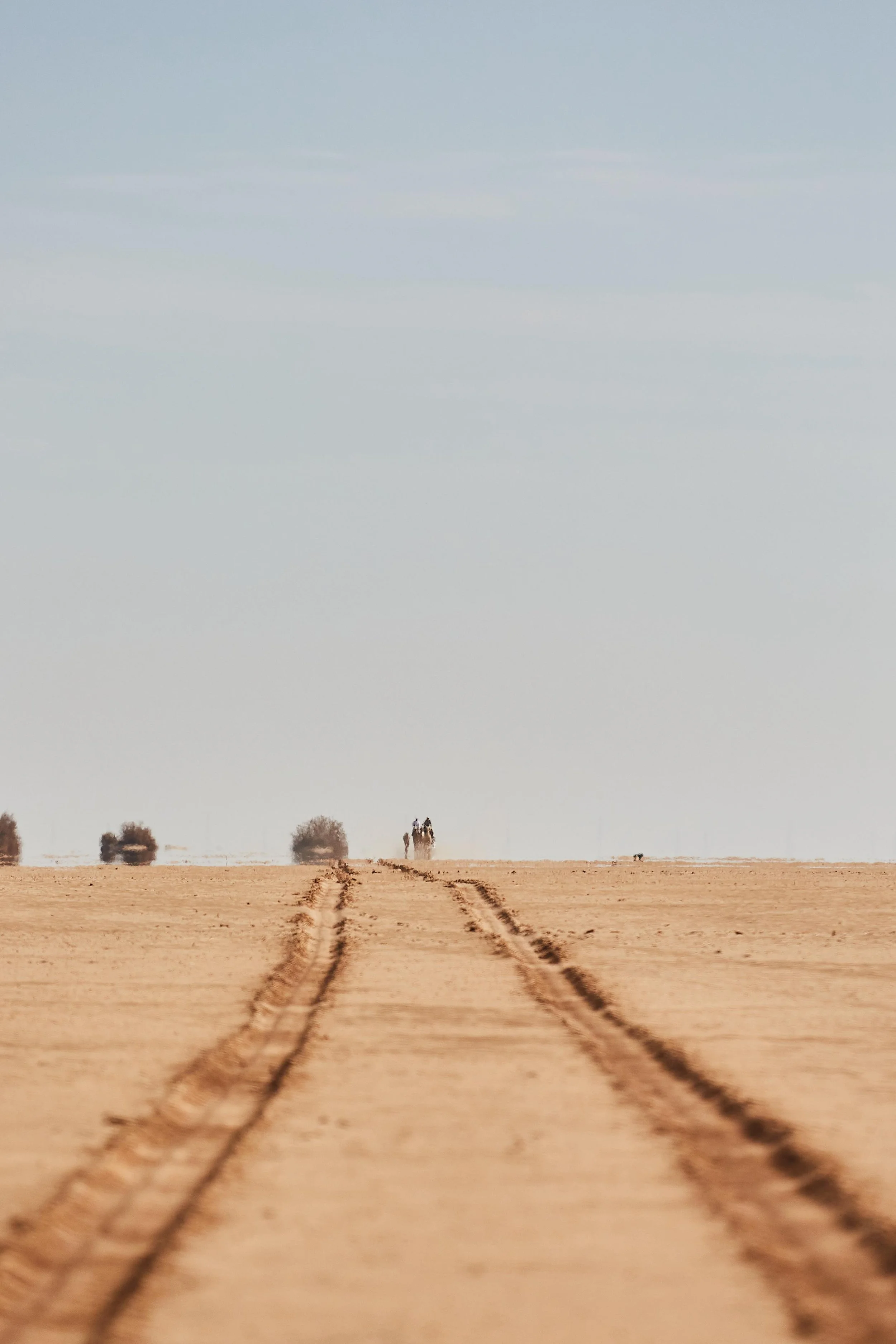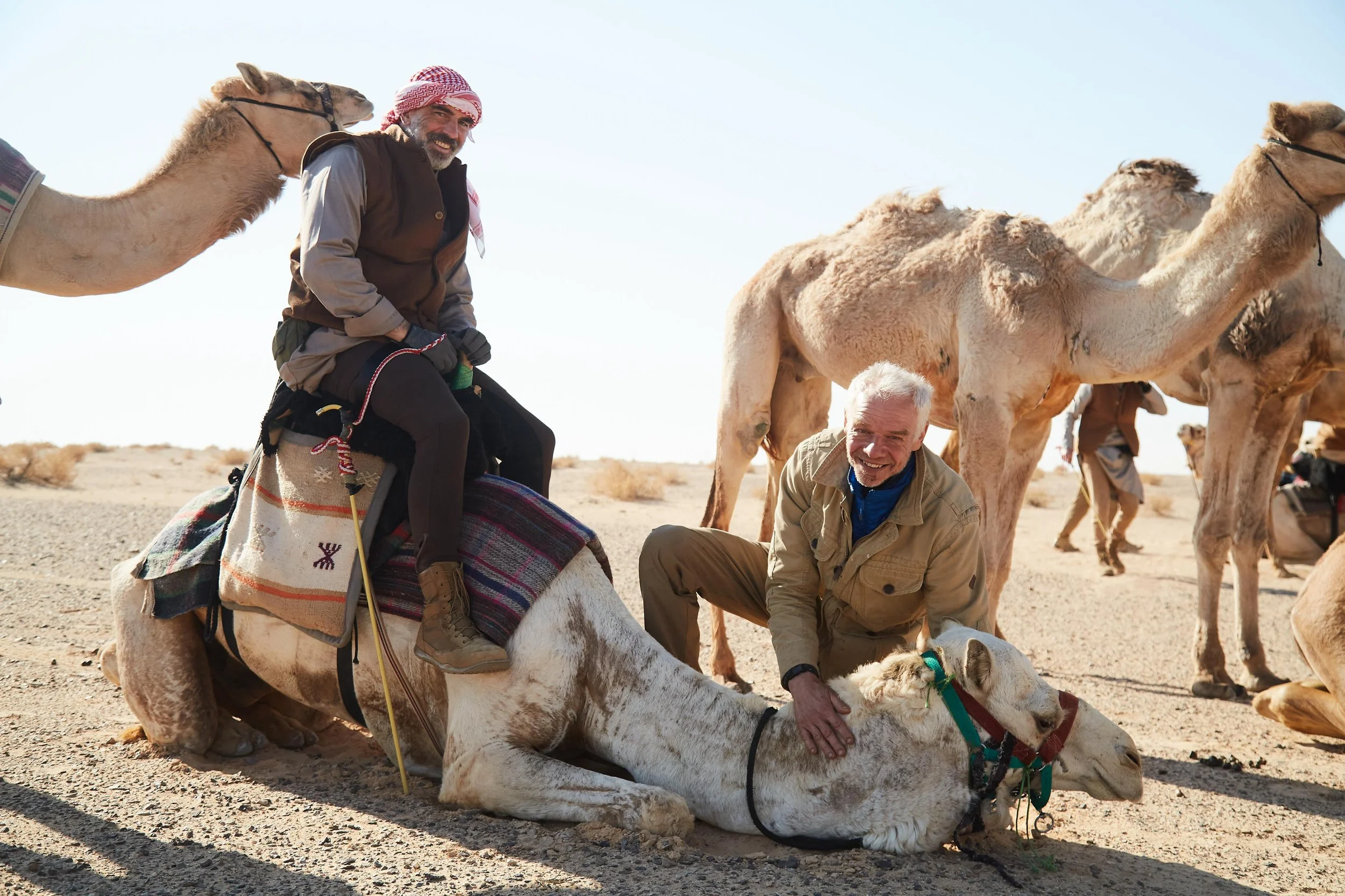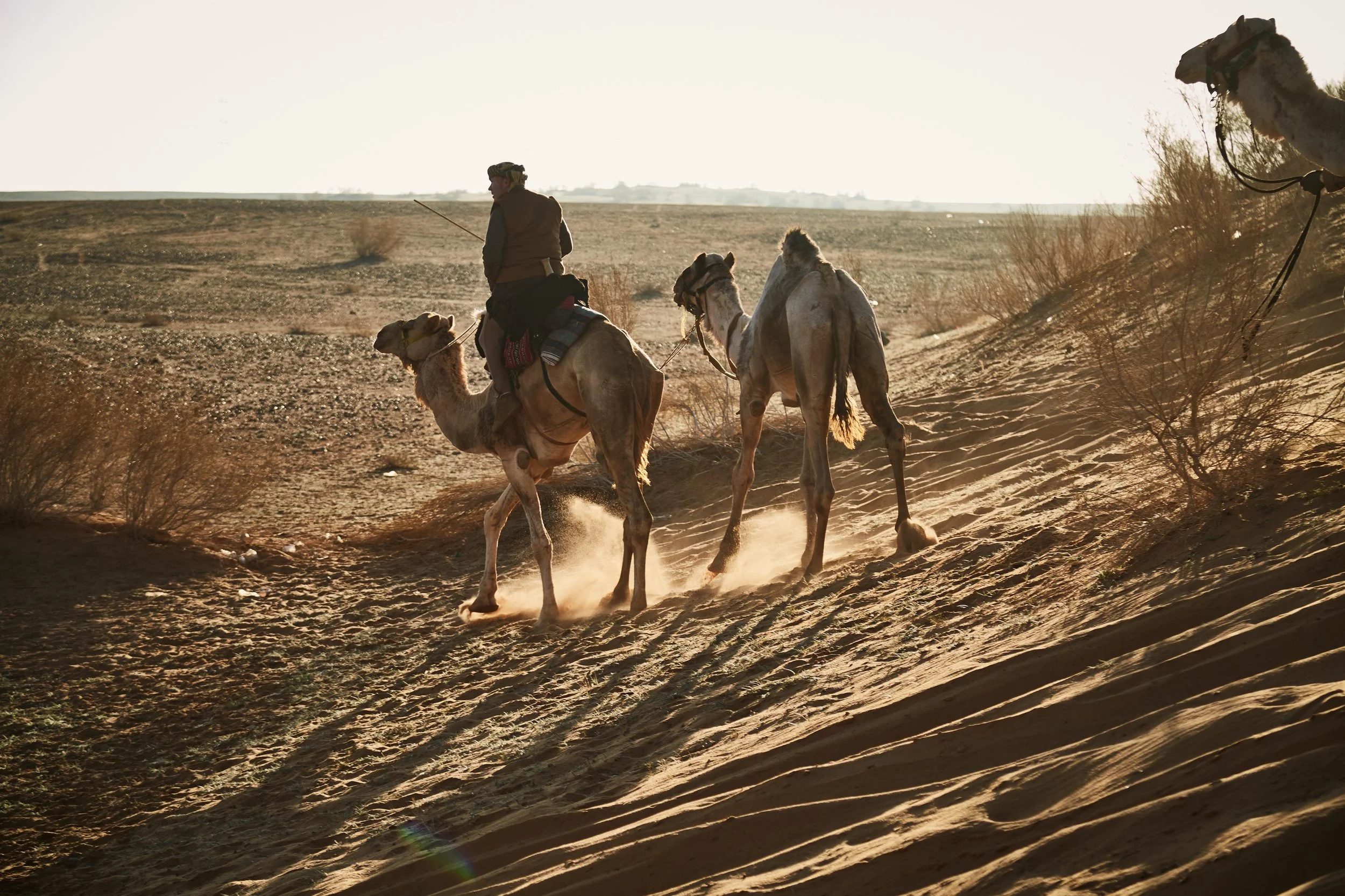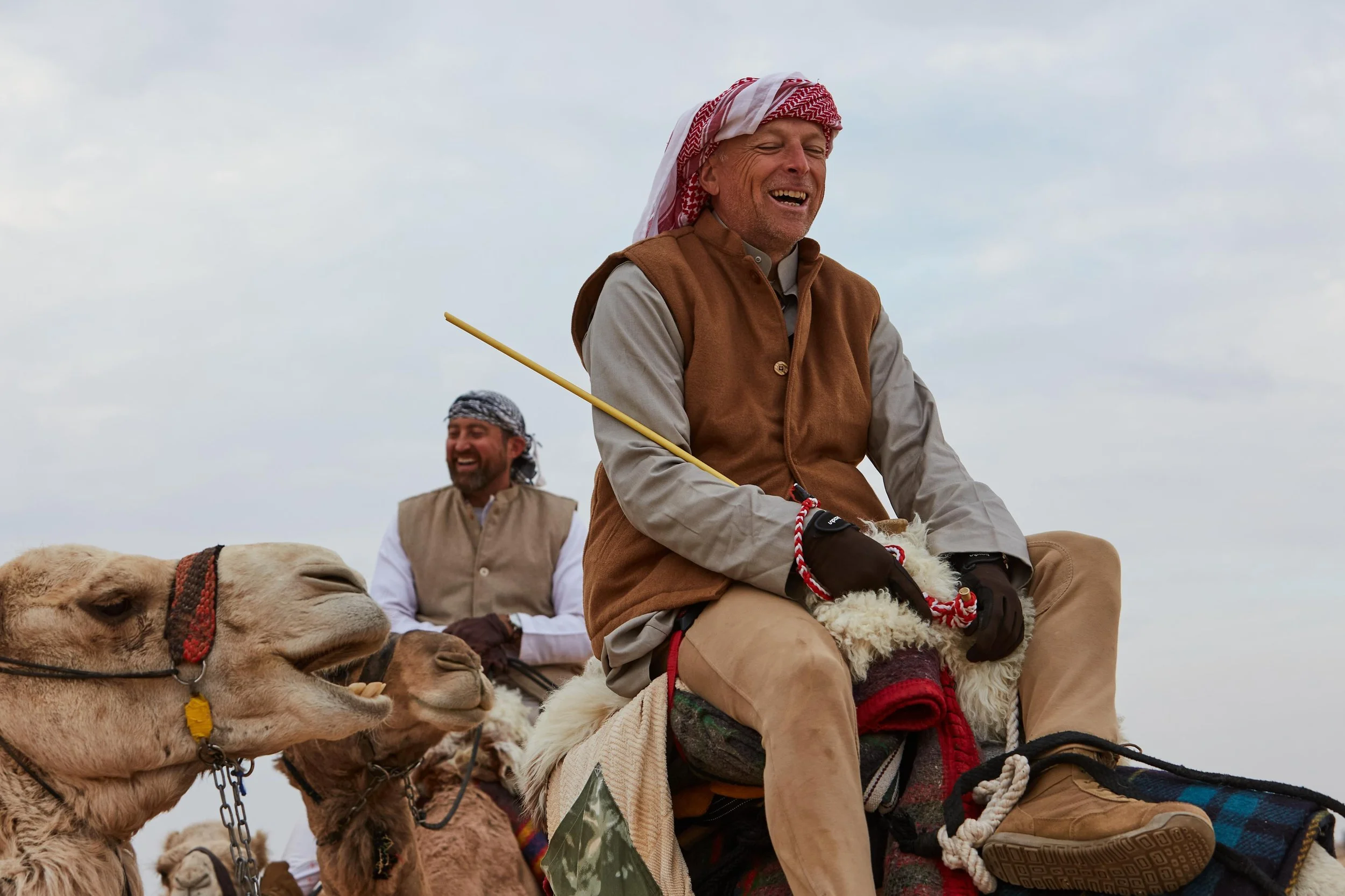Al Fajr, for The Second Pot of Sand, and then no man’s land
It had been a short night. We’d arrived at camp well after dark, with the focus on getting the camels to rest, changing out of our riding clothes, cleaning up any injuries, and getting some sleep. No sooner had my head hit the bag I was using as a pillow than my alarm was sounding in the pitch dark at 0600.
I then began the usual two-hour routine to prepare myself and my camel for the day ahead. For whatever reason, Shagra, the giant of a male camel, was none too pleased about it that morning. As I pulled the girths under his colossal, though still seated, body, he tried to take a chunk out of my back.
At 0800, we walked the camels out of camp, and Henry stopped us to get some photos — it was a blue-sky, sunny morning with hills as the backdrop. We then mounted and headed toward the main road, which we’d have to cross before paralleling it on a north-easterly heading toward Al Fajr, a small oasis and well that Lawrence had written about in Seven Pillars. When he and his group of 45 Arabs and about 120 camels arrived there, they stayed for several days to replenish themselves and the animals; we’d have no such luxury.
The Special Forces Rangers from the King Salman Royal Nature Reserve were waiting for us when we reached the main road and stopped all the traffic, enabling us to cross safely. We then picked up a track that ran alongside the road for several kilometres, which allowed us to hit a steady trot and ‘eat ground’.
James then confessed he’d forgotten to pee, blaming Henry’s photo session as we left camp. He insisted his bladder was about to erupt from all the bouncing, so we stopped for a few minutes while we all emptied ours. Then on we went, with trucks and cars blaring their horns as they passed us in both directions.
The change in terrain was, once again, radical. No savage rocks like the previous day; instead, we had soft sand under camel-foot. As we closed in on Fajr, sparse shrubs and grass began to appear to our left. At this point, we left the guidance of the road and joined what looked like a dried-up, but very shallow riverbed, one which perhaps flooded slightly every few years.
Regardless, we trotted on, with Shagra dipping his head and munching on desert greenery without stopping or slowing. I’ll admit, at first, he caught me out with this, giving me some rope burns on my fingers from the rope khatam (rein). But by now, I could almost tell when he was homing in on a bush or clump of grass, so I’d relax my grip and let him grab a mouthful of whatever he could while not slowing his pace.
The hills to our left curved around to the left, and just gone midday, we spotted a few buildings and trees; this must be Fajr. The Defenders had ranged ahead, and Rebecca, Henry, Rory, and Ged had arranged their vehicles with an awning stretched between them, giving us some much-needed respite from the sun, which was now pushing temperatures into the thirties.
Fajr was tiny. On the road that ran through it, we could see just a mosque, a shop, and a filling station. We were nestled about a kilometre from the road, just outside a fenced goat farm. I didn’t tie Shagra, I figured I’d let him roam, with Sorpan tied to him. That way, they couldn’t go far but could at least graze on the greenery of this pretty little place. As I watched the camels in their contentment, I could envisage the group that had come through here in 1917. They were still many weeks from their objective of Aqaba, whereas we had just 17 days to make it there. However, the originals must have known that the water and food they found here would sustain them until the next oasis at Meegowa. No wonder they had stayed a few days.
Our schedule was not so kind. We’d only covered about half the day’s ride, so we still had over 25 km to go. After fruit, yoghurt, and coffee, we cracked on. The desert became a very gradual climb, the sand darkened to a deeper shade of red, and there was a preponderance of volcanic black rocks and features on either side of us.
A film crew from the nature reserve joined us and flew their drone — until it crashed. We pressed on, and in places we could see the trucks on the distant, parallel road; at other times, the wind would carry their noise many miles into the desert. As the afternoon wore on, the wind picked up and the temperature began to drop, but the camels were doing well. Craig’s “Begbie”, a savage of a camel but hard as nails, took the lead, which prompted the others to respond and pick up the pace.
We were in uncharted territory, so although planning had identified what appeared to be a decent campsite on Google Maps, I’d asked Simon to make sure wherever we stopped was sheltered from both view and wind. Once again, we received a message that they had found a site, but it was a few kilometres further than originally planned, which was always an arse- kicker at the end of the day… literally.
Once again, Rory had ranged back from the camp, and we picked up his flashing headlights, hoping he was by the camp. Sadly, we still had a few more kilometres to go. But when we finally reached the camp, we found a large rock feature with a narrow entrance, tucked into a hidden spot and shielded by rock faces on all four sides, which protected us from the wind. It was a perfect choice.
The only downside was the use of the lavatory hole. The Bedouin had decided to climb the rocks and would shout a cheery “Mr Howard!” greeting just as I was taking a dump. I won’t write here what I told them to do, but it involved two words that encapsulate sex and travel.
The following morning was probably the coldest by wind chill we’d had so far. We were now higher in terms of altitude than Britain’s highest mountain, and outside our sheltered hideaway, the wind was whipping across the Nefud Plain. Additionally, there was a sheet of high-stratus cloud, so the Sun wouldn’t be warming us today.As we left camp, Henry wanted some pictures of our Constantine Weisz watches. These were replicas of the 1915 Aviator Chronometer worn by Lawrence. His had been an Omega, but they declined to make us any, so this small German watchmaker, who made the replicas, had done so. When I first contacted their owner, Dirk Motz, he thought it was a hoax. But as soon as he realised what was going on, he made a small number of watches for the riders, which we wore for the entire Trek. At the time of writing, and due to the Trek, Constantine Weisz Trek watches are now worn by Kings, Princes, Princesses, Lords, billionaires, and of course… the Trek team!
As we left camp that morning, it was the first time I’d felt the need to use my head-over across my face to protect my lungs from the sting of the cold air. We’d also elected not to wear our desert coats because sweating in these conditions would be a recipe for hypothermia. Additionally, as much as possible, the riders always tried to maintain the same outward appearance in terms of layers. I think it was half aesthetics… and half old military habits dying hard!
Once again, the terrain was constantly changing. We came into green sand shallows that, in theory, should have been kinder to the camels than the surrounding stone desert. However, in practice, these areas were littered with what we came to call “baby’s heads”, through which the camels could not trot.
To that end, I was trying to read the ground, but it was almost impossible. I would trot wherever we could, but for the most part, we had to drop to a walk. Henry and Rebecca, in the Defender, were also struggling, ranging ahead, but well away from our route. We were definitely in camel-only terrain.
Then, as if by blessing, we reached areas of white sand, dried-up lakes. These were brilliant for pace, and we picked our way from one to the next. That said, the going in between was hard, and James was particularly struggling with his shedad. The route was bringing us closer to the road, which wasn’t ideal. Still, it was becoming increasingly clear that the only way through the rocky high ground ahead was to follow the route of the road, so we converged, thinking we’d stop for lunch there.
Sadly, the cook team had planned what they thought would be a nice surprise for us around some high ground and down a descent, which ripped into James’ arse. He was not a happy boy by the time we arrived. A snatched photo of Tommo and me applying Vaseline (to ourselves, NOT to each other) tells you everything you need to know about how tough the day had been so far.
As we left what would turn out to be the last hot lunch of the entire Trek, we ran into a quarry that was not obvious on any of the maps. We tried to cut through, but there was no way. We had to work our way back to the road, which cost us valuable time, but when we reached the road, we were able to parallel it for a few kilometres at a decent trot.
All of a sudden, there seemed to be fervent activity by the Rangers. We spotted a convoy of five or six vehicles pass us, then turn around and pull up alongside. Black SUVs and limousines with black royal plates rolled up next to us, and what I can only assume were two royal princesses wound down the windows, waving and taking pictures of us. As we rode on, the Rangers stayed back with the VIPs.
By now, the road was moving away from our route, so we veered off onto what I can only describe as a Mongolian plain. It was smooth, hard, and undulating, with a thin carpet of green, but clearly toxic vegetation, as the camels wouldn’t touch it.
Then, from several kilometres out, we spotted some dots on the horizon. It was the camp. As we got closer, I picked up the pace, and we ended up going flat out towards the welcome camp set up in the middle of this stunning plain. It was still daylight, so we had time to organise our kit and grab a cold but much-needed shower in the form of a spray bottle. That night, we were treated to the most spectacular star show the sky could offer.
It had been a good day.





